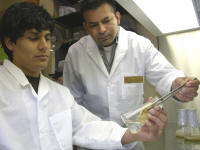University
Communications
Office
Arkansas State University
Jonesboro,
Arkansas
Staff:
Tom Moore
Sara McNeil
(870) 972-3056
fax (870) 972-3069
More information:
NewsPage
Links to News Releases
& Announcements
Campus Calendar
Public activities at ASU
Campus News
Faculty and Staff
achievements
About
ASU
Overview, history
and more |
A-State
scientists find better source
of anti-aging compound
by Dr.
Fabricio Medina-Bolivar, Plant Metabolic Engineering

Ph.D. student Mr. Jose Condori (left) and research advisor Dr.
Medina-Bolivar (right), show peanut roots grown in the laboratory to
produce resveratrol. Picture by Luis Nopo-Olazabal.
April 21, 2007 --
Last
November, a group of scientists led by Dr. David Sinclair at Harvard
published a study showing the beneficial effects of resveratrol, a
natural compound found in red wine, on expanding the life span of
rodents. Soon after this press release, the news traveled around the
world, hitting all communications media.
Resveratrol is probably one of the most recently studied compounds
derived from plants. The number of beneficial effects on human health
that have been reported for this compound are continuously increasing.
They include antioxidant properties and several anticancer properties.
Antioxidants are widely used as in dietary supplements in the belief
that they can improve health by preventing a number of diseases, such as
coronary heart conditions and even cancer.
The
presence of resveratrol in red wine has been suggested as the cause of
the phenomenon known as the “French Paradox,” where a population in
France with a high fat diet and moderate consumption of wine shows low
incidence of cardiovascular diseases.
Resveratrol is produced by certain plants in response to environmental
challenges and attack by diseases. This is why it is predominantly found
in the skin of grapes, and therefore in red wine, because the skins are
maintained for a longer period during the manufacturing of red versus
white wine. But
resveratrol is not unique to grapes. Other important plants such as
peanuts and blueberries also contain resveratrol. Because the production
of resveratrol cannot be controlled when grapes, peanuts, or
blueberries are grown in the field, the amounts of resveratrol often
vary significantly.
Together with Dr. Maureen Dolan at Arkansas State University, I recently
led a research study that shows that peanut roots grown in the
laboratory can be a source for a high quality resveratrol product.
At my laboratory at the Arkansas Biosciences Institute, I applied
several years of research experience on how to manipulate the plant
roots to produce biologically active compounds. By applying this
knowledge, I was able to induce the peanut roots to produce a specific
amount of resveratrol. Moreover, these roots can be induced to produce
other important resveratrol derivatives, such as the
cholesterol-lowering compound pterostilbene. Because of the many
applications of these compounds on the food and pharmaceutical sectors,
a provisional patent was filed by ASU to protect this discovery.
I was recently invited to present two talks and to lead the
biotechnology group at the International Symposium on Medicinal and
Nutraceutical Plants, a scientific event sponsored by the International
Society for Horticultural Science that took place in Fort Valley,
Georgia, the last week of March.
The talks highlighted our research on how to use the plant roots to
produce important medicinal compounds such as resveratrol.
This is another example of applied research that benefits the world
being conducted at Arkansas State University.
For more information contact the ASU Dept. of Biological
Sciences at biology@astate.edu.
Dr.
Medina-Bolivar is an Assistant Professor in Plant Metabolic Engineering
with a joint appointment in the Department of Biological Sciences and
the Arkansas Biosciences Institute at Arkansas State University. He was
recently honored with the Neish award for his
research on medicinal plants from the Phytochemical Society of North
America.
# # #
|
